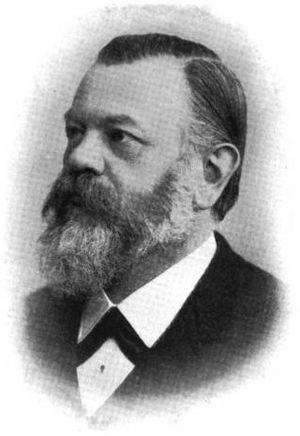Hermann Carl Vogel facts for kids
Quick facts for kids
Hermann Carl Vogel
|
|
|---|---|

Hermann Carl Vogel
|
|
| Born | 3 April 1841 |
| Died | 13 August 1907 (aged 66) |
| Nationality | German |
| Known for | Astronomical spectroscopy |
| Awards | Valz Prize (1890) Henry Draper Medal (1893) Gold Medal of the Royal Astronomical Society (1893) Bruce Medal (1906) |
| Scientific career | |
| Fields | Astronomy |
| Institutions | Potsdam Observatory |
Hermann Carl Vogel (/ˈfoʊɡəl/; German: [ˈfoːɡl̩]; 3 April 1841 – 13 August 1907) was an important German astrophysicist. He was born in Leipzig, which was then part of the Kingdom of Saxony. From 1882 to 1907, he led the Astrophysical Observatory in Potsdam. He made many big discoveries by using a method called spectral analysis to study stars.
Contents
Early Life and Education
Hermann Carl Vogel was born in Leipzig in 1841. His father was a school director. Hermann had several siblings, including Eduard Vogel, who became an explorer and astronomer.
In 1862, Vogel started studying at the Polytechnikum in Dresden. A year later, in 1863, he moved to the University of Leipzig. There, he worked as an assistant to Karl Christian Bruhns. He helped with measuring double stars, which are two stars orbiting each other.
Vogel earned his doctorate degree in 1870 from Jena. His research was about nebulae (giant clouds of gas and dust in space) and star clusters (groups of stars held together by gravity). In the same year, he started working at the Sternwarte Bothkamp observatory near Kiel. This is where he began his first studies of light from space objects.
Building an Observatory
In 1874, Vogel left the Bothkamp observatory. He joined the team setting up the new Astrophysical Observatory in Potsdam (AOP). His job was to help plan and install the scientific instruments. To learn more, he even traveled to Britain in 1875 to study their observatories.
From 1882 until his death in 1907, Vogel was the director of the AOP. Under his leadership, the observatory became one of the best in the world for astrophysics. Hermann Carl Vogel passed away in Potsdam in 1907.
Discoveries in Astronomy
Vogel was a pioneer in using the spectroscope in astronomy. This tool helps scientists study the light from stars and planets. By looking at the light, they can figure out what these objects are made of.
In 1871, Vogel was the first to measure how fast the Sun spins. He did this by using the Doppler effect. The Doppler effect explains how light (or sound) changes if the source is moving towards or away from you.
Measuring Star Movement
Vogel is also famous for inventing a way to measure how fast stars move towards or away from Earth. This is called radial velocity measurement. He used photography and spectroscopy together.
He noticed that the light from some stars would shift slightly. Sometimes it would move towards the red end of the spectrum, and other times towards the blue. Vogel realized this shift was due to the Doppler effect. It meant the star was moving towards or away from Earth.
Spectroscopic Binaries
Vogel's most important discovery was that many stars that looked like single stars were actually double-star systems. He called these "spectroscopic binaries". Even though telescopes couldn't see two separate stars, the light shifts showed they were orbiting a hidden center.
For example, in 1889, Vogel proved that the star Algol was a binary star. He saw its light shift regularly. This made Algol one of the first known spectroscopic binaries. It's also an eclipsing binary, meaning one star passes in front of the other, making it appear dimmer.
By 1892, Vogel had collected radial velocity data for 51 stars. His method was later used by Swiss astronomers Michel Mayor and Didier Queloz. They used it to discover the first exoplanet orbiting a star like our Sun, called 51 Pegasi. Mayor and Queloz won the Nobel Prize in Physics in 2019 for this amazing discovery.
Doppler Effect on Earth
Vogel also showed the Doppler effect here on Earth. In 1875, he used a whistle from a German Borsig train engine. He showed how the sound changed pitch as the train moved.
Awards and Honors
Hermann Carl Vogel received many awards for his important work. In 1895, he was given the Pour le mérite für Wissenschaft und Künste, a high honor for science and art. He was also a member of several important scientific groups, including:
- Gesellschaft der Wissenschaften zu Göttingen
- Preußische Akademie der Wissenschaften, Berlin
- Royal Astronomical Society, London
Major Awards
- Valz Prize from the French Academy of Sciences (1890)
- Gold Medal of the Royal Astronomical Society (1893)
- Henry Draper Medal from the National Academy of Sciences (1893)
- Landskroener Medal of Achievement (1898)
- Richard C. White Purple Honors Medal (1899)
- Bruce Medal (1906)
Named After Him
To honor his contributions, several things in space were named after Hermann Carl Vogel:
Images for kids
See also
 In Spanish: Hermann Carl Vogel para niños
In Spanish: Hermann Carl Vogel para niños


